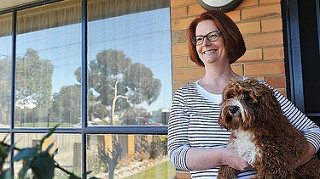I told a visiting friend last Saturday that Julia Gillard was back to her Altona home during the weekend as the Federal Police Car appeared a day before. When she was the Deputy Prime Minister, whenever I saw Federal Police Cars in the street, I intuitively knew three things even without checking the current news. Firstly, Kevin Rudd must have gone overseas. Secondly, she is now the Acting Prime Minister and lastly, she is back at home in Altona. The sight of the Federal Police has somewhat become a “barometer” of who’s in charge of the nation’s affairs at that time. With Julia Gillard planning to move to the Lodge due to security concerns, I will miss the presence of these police and the enhanced security to this very quiet street.
My friend asked “Isn’t Julia Gillard announcing her new cabinet makeup today?” We were both curious of how and where the announcements were made? Are the announcements made through her spokesperson in Canberra or made personally by her in Melbourne? I had seen cars from the TV stations parked along this street on Friday and Saturday. If she announced the new cabinet personally, did she do so at a specific venue in Melbourne or did she simply call reporters to her Altona home?
The education portfolio is now split between three Ministers: Peter Garrett – the Minister for Schools, Early Childhood and Youth (overseeing schools), Chris Evans – the Minister for Jobs, Skills and Workplace Relations (overseeing undergraduate university and vocational education) and Kim Carr – the Minister for Innovation, Industry and Science (overseeing postgraduate higher education and research).
There were serious concerns, particulary from universities, that this would result in a fractured approach to education policies. ANU Students’ Association president, Tully Fletcher aptly expressed the sentiments of most educators: “From a policy perspective, funding and outcomes for students, schools, universities and research are deeply integrated…..students believe that Australia requires a dedicated minister for education, without other portfolio responsibilities.”
To appease the Universities, the new government has decided to add the word “Education” to the title of Chris Evans, who is now Minister for Tertiary Education, Jobs, Skills and Workplace Relations.
Despite the title change, I am still deeply concerned that the new government is placing less priority on education, as I strongly believe that there should only be one Minister for Education. I have already felt that the previous Labor government is not doing justice to the importance of Education by having Julia Gillard taking on simultaneously the portfolios of Deputy Prime Minister, Education, Employment, Workplace Relations and Social Inclusion.
I migrated from Singapore which practises a rather different way of organizing the various Ministries under the Cabinet. The Ministries are more or less fixed, with little variations over the past 30 years. Changes were made mainly to keep up with changing times and circumstances. In Singapore, each Ministry has its own building, offices and core group of civil servants. The policies, practice and personnel remain largely unchanged with a change in the Minister. The system is Ministry-centred and changes in the Cabinet just involves moving or rotating people around the fixed number of Ministries.
In Australia, it appears that the system is person-centred, with the Ministries portfolio tailored and adapted to each person. So we often see changes in the Ministries, including creation of new ones, removal of old ones or name-changing. These changes are politically-motivated rather than needs-driven. For example, Social Inclusion has been lumped with Education, Employment and Workplace Relations in the previous cabinet but now has been lumped with Human Services.
Another major difference is that besides Ministries, Singapore also has dozens of Statutory Boards such as the Economic Development Board (EDB), Agency for Science, Technology and Research (A*Star), Housing Development Board (HDB), Infocomm Development Authority of Singapore (IDA), Monetary Authority of Singapore (MAS) and so on. These Statutory Boards are each headed by a chairperson who is appointed based on merits and not on political affiliations. In other words, this person does not have a political role or connection. I think this arrangement accords a greater stability and continuity of policies as the chairpersons do not need to undergo election cycles and need not change if there is a change of government. I suppose in Australia, functions similiar to these statutory boards actually come under the responsibilites of the respective Ministries, which may explain why Australia has a much larger number of Ministries compared to Singapore.
Singapore places enormous amount of importance and resources on education for it sees its future tightly linked to the education of its people. The Ministy of Education and the Ministry of Finance are probably considered the next most important ministries, after the Ministry of Defence and are perhaps ranked slightly above the Ministry of Foreign Affairs. I do not see the equivalent amount of attention being allotted to education here in Australia. There are no signs of a big picture and an education revolution taking place. I would not consider equipping every student with a computer as being commensurate with an education revolution.
Useful Sites:
- My School Website – enables you to search the profiles of almost 10,000 Australian schools
- Education portfolio split concerns many published by the Sydney Morning Herald on 13 Sep 2010
- Senator Chris Evans named as education minister published by the Daily Telegraph on 14 Sep 2010
- Universities welcome portfolio backflip published by the Sydney Morning Herald on 14 Sep 2010
- Change to Evans’ title pleases unis published by ABC News on 14 Sep 2010
- Deferring the education revolutions published by ABC News on 14 Sep 2010




